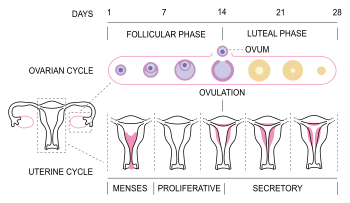Which phase usually remains constant in length of days in the menstrual cycle?
1 Answer
Good question: answer is luteal phase, i.e. the post-ovulatory phase of menstrual cycle. You may also read this .
Explanation:

Menstrual cycle in ovary has two distinct phases: follicular and luteal. These could also be termed respectively as preovulatory and postovulatory, ovulation being generally a midcycle event.
Ovulation normally takes place on 14th day of a 28 day cycle. It is prompted by-
- a high level of oestrogen (secreted by theca, present around a growing ovarian folicle)
- which in turn triggers LH (a hormone secreted by anterior pituitary) surge.
So, until and unless, a high threshold level of oestrogen in blood is achieved, LH surge can not take place. Consequently ovulation will also be delayed.
Though preovulatory stage is of 14 days in most women, it could vary in length. This is not so in case of postovulatory stage,
After ovulation, corpus luteum is formed which secretes progesteron. If there is no fertilisation, corpus luteum would gradually perish and endometrial layer would slough off. So about 14 days from ovulation, in absence of fertilisation, menstrual bleeding will start.
